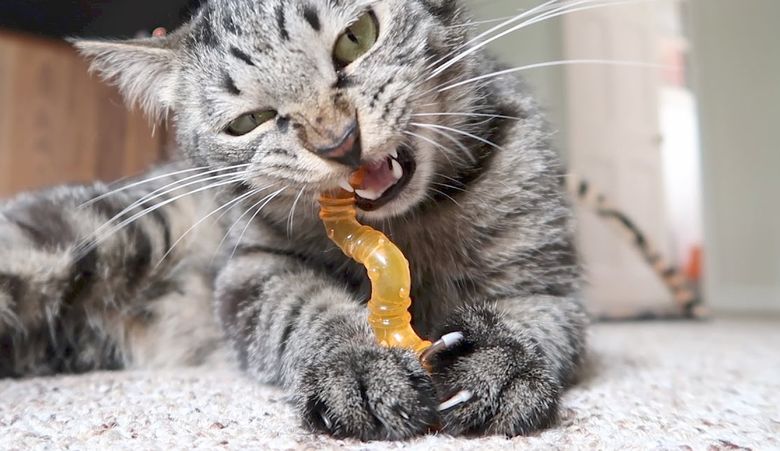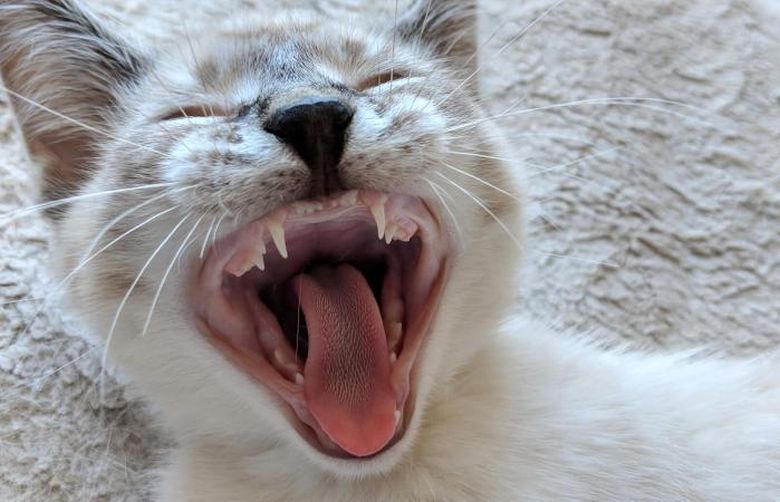Kittens are born without teeth, just like puppies and human babies. That allows them to suckle on the mother’s nipples or teats without hurting her. At around 14 days old, tiny kitten teeth begin to appear, and at the point of weaning, which is usually around four weeks when the kitten goes onto solid food, their incisors will start to develop. The premolars appear at about six weeks.
These teeth are all baby teeth or deciduous as they will be shed and replaced by a permanent set later on. Your kitten will have 26 milk teeth, which will start to loosen and fall out as the permanent teeth grow and push them out of the way. Typically this takes place at about 11 weeks old (here’s a fantastic guide from Zoo Awesome with regards to kitten care at three months).

source:pxfuel.com
By around 16 weeks, all of the permanent incisors are through, and at five months, they will have their canine teeth too. At six months, they have the premolars – there are 10 of these – and the last to arrive are the four molars which appear later on in adulthood, giving an adult cat a full mouth of 30 teeth.
Do I need to do anything when my kitten is teething?
Kittens are just like infants, some breeze through teething, and you would never know what’s going on, whereas others will experience soreness and find difficulty in eating and drinking as the milk teeth become loose. Your kitten may even exhibit signs of pain, which can make them withdrawn and quiet or aggressive and stressful, particularly if you touch the sore part of the mouth while you are playing with them or stroking them.
How can you help your kitten through the teething process?

source:catster.com
Monitor their comfort levels closely. Kittens love playing with their paws and mouths, and you may need to restrict play while the teeth are loose. If your kitten is quieter than usual, then observe them for any signs of pain or discomfort, otherwise, let them be.
If you have been in the habit of cleaning your kittens’ teeth, then you may want to desist from this during the teething period. Sometimes feeding soft food that is either damp or soaked makes it easier for the kitten to eat. If you have any real concerns or you think there is a problem with a tooth or infection present, then you should take your kitten to the vet to be checked over.
When do cats change their teeth?

source:petmd.com
These baby teeth are not permanent, so after 3 or 4 months of age, the kitten will begin to move them through the so-called permanent teeth. The process of changing teeth is much slower than the appearance of the first, so it extends until month 6 or 7 when the new denture must have already appeared completely. In this way, it is not surprising that you notice that your cat has dropped a tooth during this period.
First, the incisors appear, then the canines, then the premolars and finally a new set of pieces, the molars, until 30 teeth are developed. As we said, during the molt, you are likely to find some of the dental pieces at home. If your kitten is around the indicated ages, you have nothing to worry about.
The process is that the permanent teeth are “hidden” in the gums, so they begin to press the milk to detach and take their place. It is a natural procedure, but sometimes it is possible that a complication appears, such as a retained tooth.
It is said that a tooth is retained when the piece of milk tooth is detached despite the pressure exerted by the permanent tooth. It requires a visit to the veterinarian to determine which is the best option for all teeth to come out correctly.
Teething toys

source:youtube.com
There are teething toys for kittens, which can help offer relief to sore gums, much like teething rings do with babies. These are designed for the kitten’s teeth, so they won’t cause them to break or snap while still allowing the kitten to play and chew. Establishing a good dental routine for your kitten will pay dividends later on, but you may need to step back a little when your kitten is losing his teeth.
Characteristics of cats’ milk teeth

source:cats.lovetoknow.com
Cats are born without teeth; the first weeks of life can only be fed with the mother’s milk. The so-called baby teeth appear from the third week of life, approximately from day 16 onwards.
First, the incisors appear, then the canines and finally the premolars, until they reach a total of 26 dental pieces when they reach the eighth week. Although small, these first teeth are quite sharp, so little by little, the cat will stop breastfeeding the puppies because of the damage they are doing, so it will be time to move on to a slightly more solid, although soft, food.
Is there discomfort during the change of teeth?
The replacement of teeth of milk by permanent teeth causes different discomforts in the pussy, very similar to those experienced by children when they leave the first teeth. It is possible that your kittens:

source:killarneycat.com
- Feel pain
- Their gums get irritated
- Have bad breath
- Be irritable
- Become aggressive
Due to all these discomforts, the kitten refuses to eat mainly because of the pain it feels, but it will seek to nibble everything in his reach, as this gesture relieves a little gum irritation.
To avoid that, for these bites can destroy the furniture in your home and everything else that is on their way, we recommend you to buy cat toys made of rubber or a soft plastic so they can chew them all they want. Remove from the cat’s reach any valuables, or whatever that could cause harm if your pet bites it, offer it the toy, and reward it with caresses when it takes it to interpret that this is the object that should be chewed. Check the following article and discover the most recommended toys: “Ideal toys for small cats”.
Besides, it moistens the food you give them since solids will be difficult to chew; You can also substitute canned, dry food with it temporarily.

